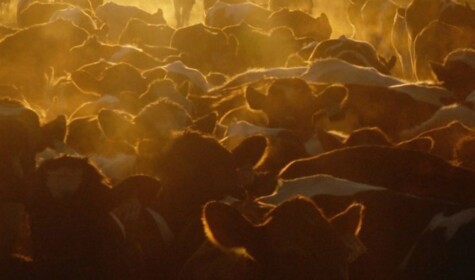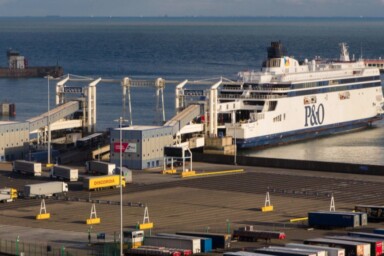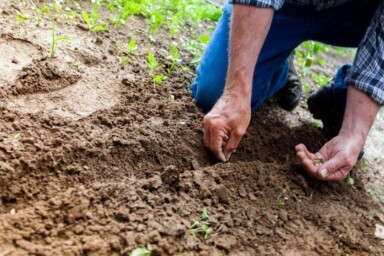I’m one of the livestock farmers very worried about the expected free-trade deal between the UK and Australia. As I am writing, the Government is said to be on the point of agreeing to allow Australian beef and lamb into the UK without the 20% tariffs that have made this uneconomical for Australian farmers until now. According to recent coverage in the Financial Times, the prime minister has ‘sided firmly with free-traders in his cabinet’ and dismissed the concerns of ministers, including Michael Gove and George Eustice who fear ‘the deal could have a particularly profound impact on Scottish and Welsh hill farms, further weakening the union’.
The deal, which, it is estimated, will only benefit the UK economy very slightly by increasing GDP by 0.01-0.02% over ten years; it is nevertheless highly significant for Brexiteers, for British farmers and for British consumers.
For Brexiteers, its symbolic importance is that the ability to strike free-trade deals was one of the key reasons they wanted to leave the EU, and their concern has been that if the UK can’t agree a relatively easy free-trade deal with Australia, it would not be able to secure similar deals with the US, Canada, New Zealand, Brazil and other countries, where the potential benefits to the UK economy are expected to be greater.
For UK farmers, including grazing livestock farms in England, the significance is that even if the amounts of beef and lamb imported from Australia are relatively small, the deal will set a precedent by creating a blueprint for future deals with other major food-producing countries that also want us to import their beef and lamb in return for being able to sell buses, lorries, excavators and other items to them, tariff-free.
The concern within the farming community is that it will prise open the flood gates to cheap imported food produced to lower animal welfare, environmental and human health standards than those in the UK. That will eventually force yet more British and Northern Irish farmers off the land and put others into the struggling farmer category, the group amongst whom depression and even suicide is already high – those who work longer and longer hours trying to find ways to survive financially so as not to leave the farms they love, not let down their families and not let down their parents, grandparents and even the memory of their great grandparents whose hard work often enabled them to get started in farming in the first place, sometimes on the same farm.
Media commentators believe the deal will be agreed before Scott Morrison, the Prime Minister’s Australian counterpart, attends the G7 summit in Cornwall as a guest next month. Consumers will no doubt then be told that it is a great deal for them and that it will help to drive down the cost of food, especially beef and lamb. What consumers won’t be told, at least not by the Government, is that hard-won high food standards will be sacrificed in return. As SFT chief executive, Patrick Holden has said, ‘The Australia trade deal undermines the UK’s leadership on climate change, animal welfare and human health. Given the overwhelming urgency of the climate crisis and the need for food systems which improve public health, it seems extraordinary that the Prime Minister would negotiate a trade deal which takes no account of these factors. All international trade in food should be restricted to climate friendly, safe and nutritious food. However, a restriction-free trade agreement will almost certainly result in imports of the cheapest beef from feedlots which is neither climate friendly nor healthy.’
Climate change
We cannot yet compare the carbon footprint of Australian beef with beef produced in the UK because there is no information on which beef and lamb will actually be exported to the UK, and the carbon footprint varies considerably according to how and whereabouts in the country meat is produced. We know that the UK produces beef and lamb with one of the lowest, if not the lowest carbon footprint on the planet, between one-third and half the global average, largely because UK grasslands are highly productive due to our temperate climate and substantial rainfall patterns. This allows grazing livestock to grow quickly and only modest amounts of grain are needed to bring some of them to slaughter weights, as the Climate Change Committee noted in its 2020 Land use: Policies for a Net Zero UK report.
If we end up importing beef from the more arid regions of Australia such as Queensland and North-Western Australia the carbon footprint is likely to be much higher than that of UK beef because the pastures are relatively poor and sparse and while cattle can grow reasonably well over winter when it rains, they generally lose weight during the summer when there is no rain. Unlike the UK, it appears that it is not common practice to feed livestock in such regions with conserved hay or silage when the grass stops growing. That’s hardly good for animal welfare but it will also increase the carbon footprint of the meat.
Rainforest clearance and other land use change associated with beef production
We tend only to associate rainforest and other forest clearance for beef production with Brazil and some other South American countries. But Australia is the one developed country on the world list of deforestation hotspots according to WWF, with 71.5 to 98.1 thousand hectares of forest being cleared annually, excluding forest lost in the devastating bush fires of recent years. In a 2019 analysis, the Wilderness Society says Australia has lost 27% of its natural rainforest and a substantial percentage of other forest and that 73% of all deforestation and land clearance in Queensland is associated with beef production. While the situation in Australia may not be exactly the same, a 2011 study in Brazil put the carbon footprint of beef from grasslands on former rainforest land at the equivalent of 700 kilos of CO2 per kilo of beef, almost 10 times the global average, and 20-30 times higher than beef produced in the UK.
International shipping
It has long been claimed that shipping food round the globe makes up only a tiny percentage of greenhouse gas emissions. The claim has been made by writer and campaigner George Monbiot on a number of occasions. For example, in response to a tweet last year from author Helen Moat who was expressing her concern, he stated, ‘In fairness, food miles is actually a very small component of the total environmental impact, except for foods that are flown in.’ Hannah Richie would agree with him. She argues that we should ‘Focus on what we eat not where it comes from’. While we should certainly focus on what we eat, it must surely be the case that if the same food can be produced locally at the same or a lower carbon footprint, then we will inevitably increase our net contribution to climate change if we unnecessarily ship food thousands of miles?
This is significant because the UK government appears to be taking the advice of its Climate Change Committee which argues that in order to meet our commitment to achieve net zero carbon by 2050, we need to reduce beef and lamb production in the UK by 10% and increase the stocking density of the remaining animals. But the government’s plan now appears to be to reduce our beef and lamb production and simply replace this with more imported meat. This needs to be avoided at all costs as it will not reduce global warming and may in fact increase it, a point clearly made by the Climate Change Committee in several reports and publicly stressed recently by the committee’s chair, Lord Deben.
Unfortunately, a breakdown of shipping emissions by commodity is not readily available, though some work has been undertaken on this issue. There is separate evidence that European countries, including the UK, are amongst those adding to climate change by increasing their dependence on imported goods, something that has received little publicity. Although international shipping makes up only 2.5% of global greenhouse gas emissions, it already accounted for 13% of emissions in the EU by 2015 and there are indications that it has increased since then and is projected to increase much further still. The reason this issue is not more widely recognised is because there is still no internationally agreed requirement to record and publish emissions from international aviation and shipping. As such, the totals are not included in national inventories submitted to the IPCC, even from those countries that monitor them. Taken together, however, aviation and shipping accounted for 27% of total EU emissions in 2017 and it seems probable that the UK’s share of this will be similar in percentage terms. This is very different to the impression most people have been given.
Offshoring
Another aspect which cannot be ignored is that by replacing meat produced in the UK with imported meat, the government will ‘offshore’ yet more of our emissions, since official figures for greenhouse gas emissions only cover those that occur in individual countries, not those that occur in the production or transport of imported food or other products to that country. This may help the UK to meet its emissions reductions target, but it will actually increase, rather than decrease, climate change.
Cheap meat
Australia is able to produce meat more cheaply than farmers in the UK for two main reasons. First, while Australian farmers and regulators maintain their food is safe, some of the meat at least is produced to very different and arguably much lower standards, than similar products in the UK. Second, the sheer scale of farming in Australia means that the large size of most farms and the very large number of animals kept on each farm, keeps the overheads per animal at a much lower level than in the UK.
Animal welfare standards
According to the RSPCA in Australia, the country is ranked D for farm animal welfare compared with B for the UK. Animals Australia paints a very dim picture of animal welfare in Australia, claiming that while each state has its own version of animal welfare legislation (Acts) prohibiting cruelty to animals, ‘in each of these Acts there are “carve out” clauses that exclude certain animals from anti-cruelty legislation if they are defined as “stock” or farm animals or animals used in research’.
They claim that such animals then come under industry codes of practice rather than animal welfare legislation. None of these are available free of charge so it’s not clear exactly how they compare with UK codes of practice. National guidelines for beef cattle in feedlots in Australia have not been updated since 1997. The booklet costs AU$30 (£16.50) and the promotional material states, ‘Awareness of them [the guidelines] will help Australia compete effectively in our major beef export markets.’
One key area of concern is that cattle and sheep can be transported for up to 48 hours without water, food or rest. RSPCA Australia puts this in the context of the very high temperatures that the animals sometimes have to endure. Incredibly, while making a range of appropriate recommendations, including that farmers should ‘Avoid extreme weather’ when transporting animals, Meat and Livestock Australia also advises them to ‘Hold stock off feed and water for 8-12 hours prior to transport if possible’, suggesting that cattle and sheep could be forced to go without water for 60 hours before arrival at a feedlot or slaughterhouse. Since these are recommendations rather than enforceable legislation one has to wonder how often the need to keep slaughterhouses supplied with livestock causes farmers to transport animals during very hot weather all the same?
Australia also has a very dubious record in relation to the live export of farm animals. After a whistleblower exposed how dreadful conditions can be for live cattle shipped to the Middle East for slaughter, the former Labour government, led by Julia Gillard, banned all live exports. After a long campaign, supported by the current prime minister, Scott Morrison, a federal court ruled in 2020 that the blanket suspension of live cattle exports in 2011 was invalid, ‘capricious and unreasonable’. Things appear no better with the live export of sheep. RSPCA Australia asks ‘Why does the government keep giving in to them?’ (i.e. exporters who even break what rules there are governing live exports).
Veterinary antibiotics and antibiotic growth promoters
Unlike the UK, EU countries and even the US, Australia does not publish information on farm antibiotic use annually and has a very poor national surveillance system. In fact, the most recent data relates to 2005-2010 and the official report, published in 2014 acknowledges the data may not be complete. There is a suspicion that antibiotic use is high, because the poor welfare conditions result in increased levels of disease. Analysis by the Alliance to Save Our Antibiotics found that use in pigs and poultry was respectively 2.7 and 16.6 times higher than in the UK per kilo of meat produced. There was, however, insufficient data from Australia to undertake a similar calculation in relation to the use of antibiotics in cattle production.
Antibiotics specifically for growth promotion
What we know, however, is that Australia still permits the use of antibiotics specifically to increase growth rates – products that have been banned in the UK.
Starting in 1997, use of the last 11 antibiotics allowed in animal feed and water specifically to increase growth rates and egg and milk production was phased out by 2006. This took place against strong industry opposition, but with the support microbiologists and some of the regulatory committees.
In 2017, Australia introduced a voluntary agreement with the industry that antibiotics ‘of importance to human health’ would no longer be labelled and marketed as growth promoters. However, definitions of ‘medically important’ vary, and Australian livestock producers can still legally use at least five antibiotics for growth promotion that have been banned on farms in the UK for all purposes: avilamycin, bambermycin, bacitracin, olaqindox and salinomycin, plus monensin which still has some medical uses on UK farms. This looks like a classic compromise between regulators and the industry which allowed Australian farmers and feedlot companies to continue using a wide range of drugs that increase growth rates in farm animals, while being able to say to consumers that they have stopped using medically important antibiotics to increase growth rates.
These antibiotics were completely banned in UK farming under the precautionary principle due to concerns that antibiotics are so important that they should no longer be used simply to increase growth rates, due to the potential for antibiotic resistance and co-selection in zoonotic pathogens to spread to humans. However, as reports by the Sustainable Food Trust and the Alliance to Save our Antibiotics detail, there is increasing evidence to justify keeping these bans in place.
Several strands of recent research have found that bacitracin can induce resistance to the antibiotic colistin which is known to be cross-resistant with polymyxin B, an antibiotic used as a hospital antibiotic of last resort, to treat patients with multi-drug resistant E. coli and other infections that can rapidly cause sepsis and death when they fail to respond to all other antibiotics. Avilamycin is cross-resistant with everninomicin, an antibiotic capable of further development for use in human medicine, while bambermycin has low toxicity and potential for development in human medicine. Trials using salinomycin have shown it can kill cancer cells. Monensin is still permitted in the UK to control a parasite in poultry and as a slow release, stomach bolus in dairy cattle to prevent acidosis in high yielding dairy cows. In Australia, it is also permitted as a growth promoter in beef cattle. Research has shown that it has the potential to be developed as a medical antibiotic, an anti-cancer drug and an anti-viral drug.
Hormones and Beta-agonists
Until the mid-1980s, UK cattle farmers were also permitted to use six hormones in beef cattle to make them grow faster. Due to examples of misuse and research from Denmark suggesting a potential increased risk of cancer in later life when beef containing raised levels of hormones was consumed by pre-pubescent children and post-menopausal women, all six hormones were banned in the UK and throughout the EU. Their use, however, continues in the US, Australia and a number of other countries, and is predominantly associated with cattle in feedlots. In addition to the potential problems associated with the use of hormones, antibiotics of medically important classes are implanted under the skin (see p19-20) at the same time to reduce the risk of infection caused by dirty equipment when large numbers of cattle are treated on the same day.
In the UK, drug companies attempted to introduce a replacement class of growth promoter called beta-agonists that are not technically hormones, but steroids. However, public opposition was strong and regulatory committees failed to approve them due to a lack of adequate data from the drug companies on residues and their impact on human health. In the only trial in humans, one of six volunteers had to pull out due to cardiovascular problems. See chapter 3 of our report, Maximum Growth: Whatever the Cost. One of these drugs, ractopamine is still permitted in beef, pork and turkey production in the US. In Australia, it is only licenced for use in pork production. Media reports in Taiwan, one of the countries that imports Australian meat have linked samples of beef found to contain beta-agonists with Australia, something the Australian Office Taipei has strenuously rejected. Singapore, another country that imports Australian meat has recently introduced tighter limits on the permissible levels of ractopamine in pork.
Scale
While some farms in Australia are not that dissimilar in size to those found in parts of the UK, the average size of farms in Australia is 4,331 hectares (10,702 acres). This compares with the average farm size of 86.4 hectares (213 acres) in the UK. But when it comes to the farms mostly producing for export markets, scale is of a completely different order. Australia’s largest beef farm, Anna Creek Station, is 2,367,867 hectares in size (5,851,000 acres). Cattle numbers fluctuate between about 10,000 and 17,000 but can drop to 1,500 during severe droughts. On average there is one staff member per 1,000 cattle. Cattle are inspected by light aircraft and rounded up by stockmen on motorbikes. Farms like this in dry regions can have reasonable grazing during the winter but cattle lose weight during the summer when there is little or no rain.
Conclusions
At the present time it is not financially attractive for Australian farmers to export meat to the UK, due to import tariffs. These are typically 12% plus £2.54 for boned out beef (approximately 20%), less for carcase beef and similar amounts for lamb and mutton. Even if the deal is struck by the G7 meeting in mid-June, it is not clear how soon any trade deal with Australia would take effect. It has been suggested that the tariffs might be progressively reduced over several years. But this is also the period during which food production direct payments to British farmers are being phased out, subsidies that make up over 90% of the profit of beef and sheep farms (see Fig 12, p36) in the country. The phrase that is used is ‘to allow UK farmers to adjust’. But all this can mean is to allow the largest beef and sheep farmers to become larger still, by taking over the land farmed by those forced out, and for those farmers also to intensify further. Amazingly, after all the concern there has been about over-stocking and the grant schemes that have paid farmers to keep less than optimal cattle and sheep numbers on their grassland, the UK’s Committee on Climate Change has recommended that stocking rates in the UK should be increased significantly.
It goes without saying that Australia is a huge country with a wide range of soils and climates. There are undoubtedly many examples of excellent farming in Australia. Something like 8% of its land is farmed organically and many farmers are adopting regenerative agriculture in order to restore soils that have been degraded by past agricultural exploitation and improve existing pastures. One of many outstanding examples is Willmott Cattle Co in New South Wales, which is carefully monitoring the very large amounts of carbon being sequestered into its permanent grassland soils, as detailed in this article we published in February and the article linked to it.
But there are also many examples of farming on such a huge scale over such vast areas, that the potential to provide care at an individual animal level is challenging and often impossible. Weak or missing animal welfare legislation and the long-distance transport, with cattle and sheep forced to travel for unacceptably long periods without food, water or rest, is something British consumers need to know about. Will they have clear consciences if they consume meat produced in that way? Will they even know what they are eating, if Australian beef goes into restaurants, pubs and fast food outlets?
But perhaps the greatest concern is that Australia is still involved in converting natural forest to agriculture. That means that at least some beef and lamb produced in Australia will have a carbon footprint ten, twenty, perhaps even thirty times higher than beef and lamb produced in the UK. That raises the very, very serious question of whether the UK government is serious about tackling global warming and its increasingly obvious negative impact on the climate, or whether it is only interested in being able to trumpet its success in reducing emissions in the UK, while turning a blind eye to the climate change consequences of some of its policies?
So, my plea to the prime minister is, please wake up to the world in which we live and start making decisions that will help us to address the really big challenges we face, rather than continuing to take seriously flawed decisions for short term political expediency. Your place in history will be judged on the former, not the latter.
Photograph: Andrew Wallace






